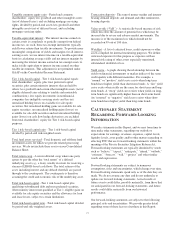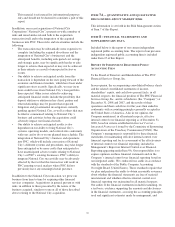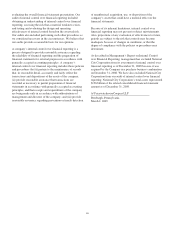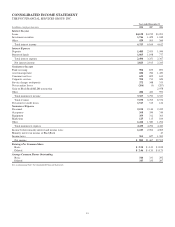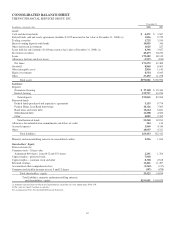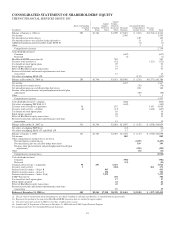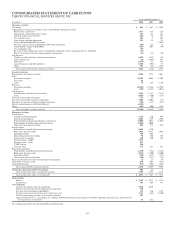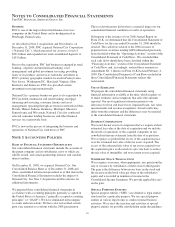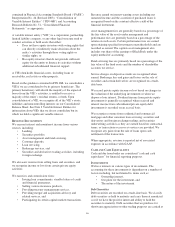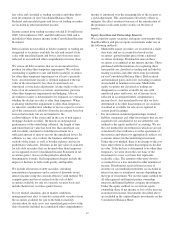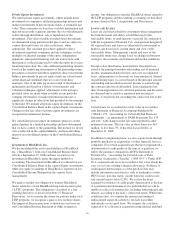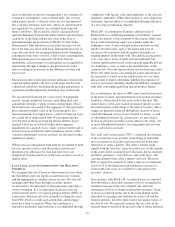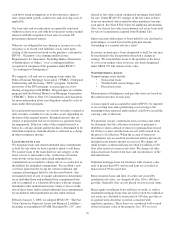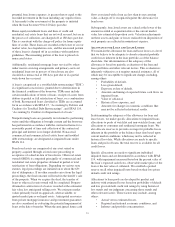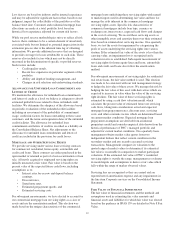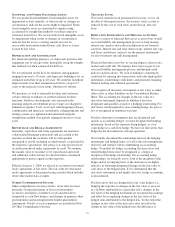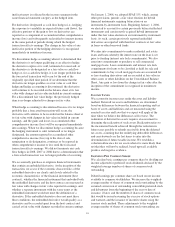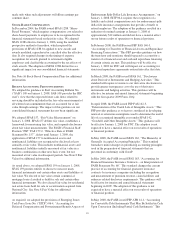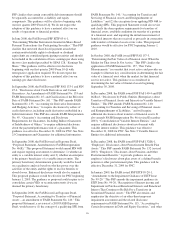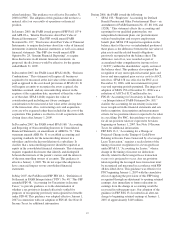PNC Bank 2008 Annual Report Download - page 91
Download and view the complete annual report
Please find page 91 of the 2008 PNC Bank annual report below. You can navigate through the pages in the report by either clicking on the pages listed below, or by using the keyword search tool below to find specific information within the annual report.fair value and classified as trading securities and other short-
term investments on our Consolidated Balance Sheet.
Realized and unrealized gains and losses on trading securities
are included in other noninterest income.
Income earned from trading securities totaled $116 million in
2008, $116 million in 2007, and $62 million in 2006 and is
included in Other interest income in the Consolidated Income
Statement.
Debt securities not classified as held to maturity or trading are
designated as securities available for sale and carried at fair
value with unrealized gains and losses, net of income taxes,
reflected in accumulated other comprehensive income (loss).
We review all debt securities that are in an unrealized loss
position for other-than-temporary impairment. We evaluate
outstanding available-for-sale and held-to maturity securities
for other-than-temporary impairment on at least a quarterly
basis. An investment security is deemed impaired if the fair
value of the investment is less than its amortized cost.
Amortized cost includes adjustments (if any) made to the cost
basis of an investment for accretion, amortization, previous
other-than-temporary impairments and hedging. After an
investment security is determined to be impaired, we evaluate
whether the decline in value is other than temporary. When
evaluating whether the impairment is other-than-temporary,
we take into consideration whether or not we expect to receive
all of the contractual cash flows from the investment based on
factors that include, but are not limited to: the
creditworthiness of the issuer and, in the case of non-agency
mortgage-backed securities, the historical and projected
performance of the underlying collateral; the length of time
and extent that fair value has been less than amortized cost;
and our ability and intent to hold the investment for a
sufficient amount of time to recover the unrealized losses. In
addition, we may also evaluate the business and financial
outlook of the issuer, as well as broader industry and sector
performance indicators. Declines in the fair value of available
for sale debt securities that are deemed other than temporary
are recognized on our Consolidated Income Statement in net
securities gains / (losses) in the period in which the
determination is made. Such impairment charges include the
impact of declines in both credit quality and liquidity.
We include all interest on debt securities, including
amortization of premiums and accretion of discounts in net
interest income using the constant effective yield method. We
compute gains and losses realized on the sale of debt
securities available for sale on a specific security basis and
include them in net securities gains/(losses).
In very limited situations, due to market conditions,
management may elect to transfer certain debt securities from
the securities available for sale to the held-to-maturity
classification. In such cases, any unrealized gain or loss at the
date of transfer included in accumulated other comprehensive
income is amortized over the remaining life of the security as
a yield adjustment. This amortization effectively offsets or
mitigates the effect on interest income of the amortization of
the premium or discount on the security on the date of
transfer.
Equity Securities and Partnership Interests
We account for equity securities and equity investments other
than BlackRock and private equity investments under one of
the following methods:
• Marketable equity securities are recorded on a trade-
date basis and are accounted for based on the
securities’ quoted market prices from a national
securities exchange. Dividend income on these
securities is recognized in net interest income. Those
purchased with the intention of recognizing short-
term profits are classified as trading and included in
trading securities and other short-term investments
on our Consolidated Balance Sheet. Both realized
and unrealized gains and losses on trading securities
are included in noninterest income. Marketable
equity securities not classified as trading are
designated as securities available for sale with
unrealized gains and losses, net of income taxes,
reflected in accumulated other comprehensive
income (loss). Any unrealized losses that we have
determined to be other than temporary on securities
classified as available for sale are recognized in
current period earnings.
• For investments in limited partnerships, limited
liability companies and other investments that are not
required to be consolidated, we use either the cost
method or the equity method of accounting. We use
the cost method for investments in which we are not
considered to have influence over the operations of
the investee and when cost appropriately reflects our
economic interest in the underlying investment.
Under the cost method, there is no change to the cost
basis unless there is an other than temporary decline
in value. If the decline is determined to be other than
temporary, we write down the cost basis of the
investment to a new cost basis that represents
realizable value. The amount of the write-down is
accounted for as a loss included in other noninterest
income. Distributions received from income of
investee on cost method investments are included in
interest income or noninterest income depending on
the type of investment. We use the equity method for
all other general and limited partner ownership
interests and limited liability company investments.
Under the equity method, we record our equity
ownership share of net income or loss of the investee
in noninterest income. Investments described above
are included in the caption Equity investments on the
Consolidated Balance Sheet.
87


